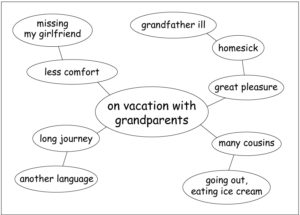
This method works well for trying to find ideas for imaginative texts associatively, e. g. for a story or an imaginative text. The instructor provides an example, similar to the one above, with the following instructions: take a sheet of A4 or A3 paper sideways. In the middle of the page, write the title or topic you will write about. Circle the title. Around this, jot down your ideas and circle them. Some of the ideas lead to other thoughts, lines and circles and whole chains of ideas. If you have difficulties doing the cluster in the first language, you may use the school language. After about 5 minutes you should look at your collection of ideas and mark in color and numbers the ones you want to use in writing your text and in which order to use them.






